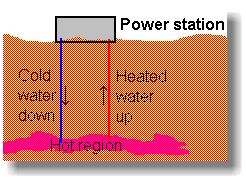 ......... .......
......... ....... 
The centre of the Earth is around 6000 degrees Celsius - hot enough to melt rock. Even a few kilometres down, the temperature can be over 250 degrees Celsius. In general, the temperature rises one degree Celsius for every 36 metres you go down.
In volcanic areas, molten rock can be very close to the surface. Geothermal energy has been used for thousands of years in some countries for cooking and heating.
The name "geothermal" comes from two Greek words: "geo" means "Earth" and "thermal" means "heat"..
 ......... .......
......... ....... 
Hot rocks underground heat water to produce steam.
In a few places in the world, heat from the earth, called geothermal energy, can be collected. Usually, engineers try to collect this heat in the rare places where the Earth's crust has trapped steam and hot water. Here, they drill into the crust and allow the heat to escape, either as steam, or as very hot water. Pipes carry the hot water to a plant, where some of the steam is allowed to "flash," or separate from the water. That steam then turns a turbine - generator to make electricity..
There may be natural "groundwater" in the hot rocks anyway, or we may need to drill more holes and pump water down to them.


New Zealand, because it is on the Ring of Fire, has steam and very hot water trapped under ground. If you go to Rotorua, you can see evidence of it everywhere. So New Zealand built Waiwera, which was only the second geothermal power station to be built in the world.

ADVANTAGES
Geothermal energy does not produce any pollution, and does not contribute to the greenhouse effect. The power stations do not take up much room, so there is not much impact on the environment. No fuel is needed to run the power stations, so that means that once you've built a geothermal power station, the energy is almost free. It may need a little energy to run a pump, but this can be taken from the energy being generated.
DISADVANTAGES
The big problem is that there are not many places where you can build a geothermal power station. You need hot rocks of a suitable type, at a depth where we can drill down to them. The type of rock above is also important, it must be of a type that we can easily drill through.
Sometimes a geothermal site may "run out of steam", perhaps for decades. It can also affect nearby geysers or hot springs - if you take too much energy out of the geothermal field. It is a renewable form of energy, as long as we don't pump too much cold water down, and cool the rocks too much.